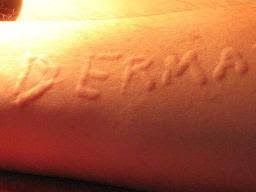Skin Writing!
Jun 28, 2019 • 25 views
Dermatographia is a skin condition which is also sometimes known as skin writing. In this, even because of a minor scratch, individuals develop raised welts resembling writing when the scratches turn into significant reactions but they are temporary ones. The resulting hives do not itch. Dermatographia hives frequently appear in areas like- on the scalp, in the genital area, and on the soles of the feet. The marks usually disappear within thirty minutes. This condition is also called dermographism or dermatographic urticaria. This condition is very rare with approximately only 5 percent of people suffering from this condition and it is the most common condition in older children and younger adults. In dermatographic condition, the scratches worsen giving rise to deep wounds and even allergic reactions. Rare cases need medical treatment from dermatologists.
The causes of dermatographia are unknown but it can get activated in some people by infections, emotional upsets or due to some medications such as penicillin.

CAUSE
Dermatographia is an allergic reaction when specific antibodies (IgE and IgM) are released in response to scratching, mild irritation or pressure on the skin leading to the release of histamines, which cause the welts. Researchers could not find a strong genetic link to dermatographia, although 14 percentof those surveyed cases in a recent study, reported a family history of this condition.
Simple things like rubbing from one’s clothes or bedsheets can also trigger dermatographic conditions. Stress, a history of allergies, exercise leading to excessive rubbing can also result in dermatographia.
SYMPTOMS OF DERMATOGRAPHIA
Hive like welts, swelling, itching, raised red lines, inflammation, etc. In rare cases, symptoms last for a day or longer. The condition of dermographism may itself last for months or years.
RISK FACTORS
An individual may be at increased rate if-
One has dry skin, history of dermatitis, experience frequent scratches on skin, thyroid or a nerve disorder or an internal illness that causes itchy skin. Children are more susceptible to dermatitis but young adults are more prone to develop dermatographia.
DIAGNOSIS
Dermatographia is diagnosed with skin test in which doctors use a tongue depressor and drag it across a portion of skin to check. Doctors may also check other areas of skin for marks. No blood tests are required to diagnose the condition.
TREATMENTS
Dermatographia may not need medical treatment until dermatographia becomes chronic. Symptoms are treated with over-the-counter medications. It’s better not to take any new medications, herbs or supplements without consulting a doctor first.
